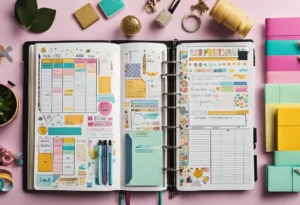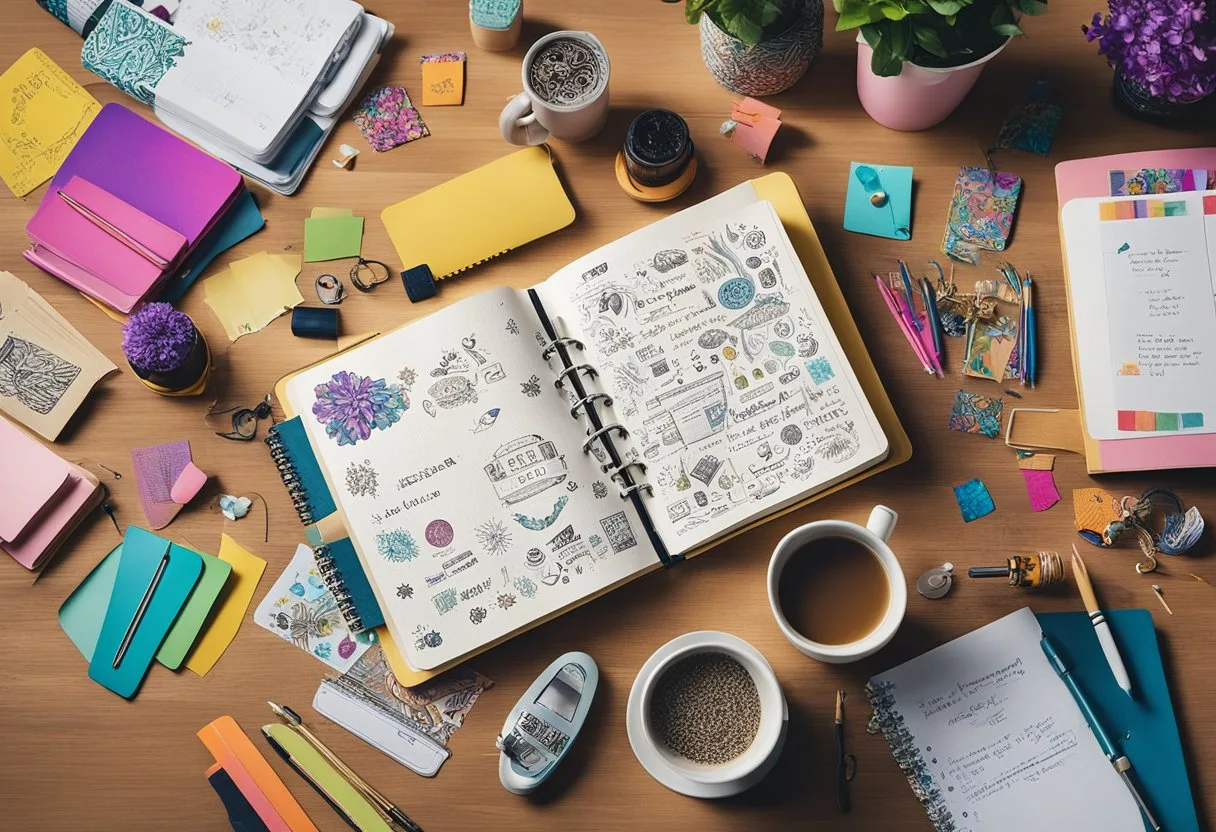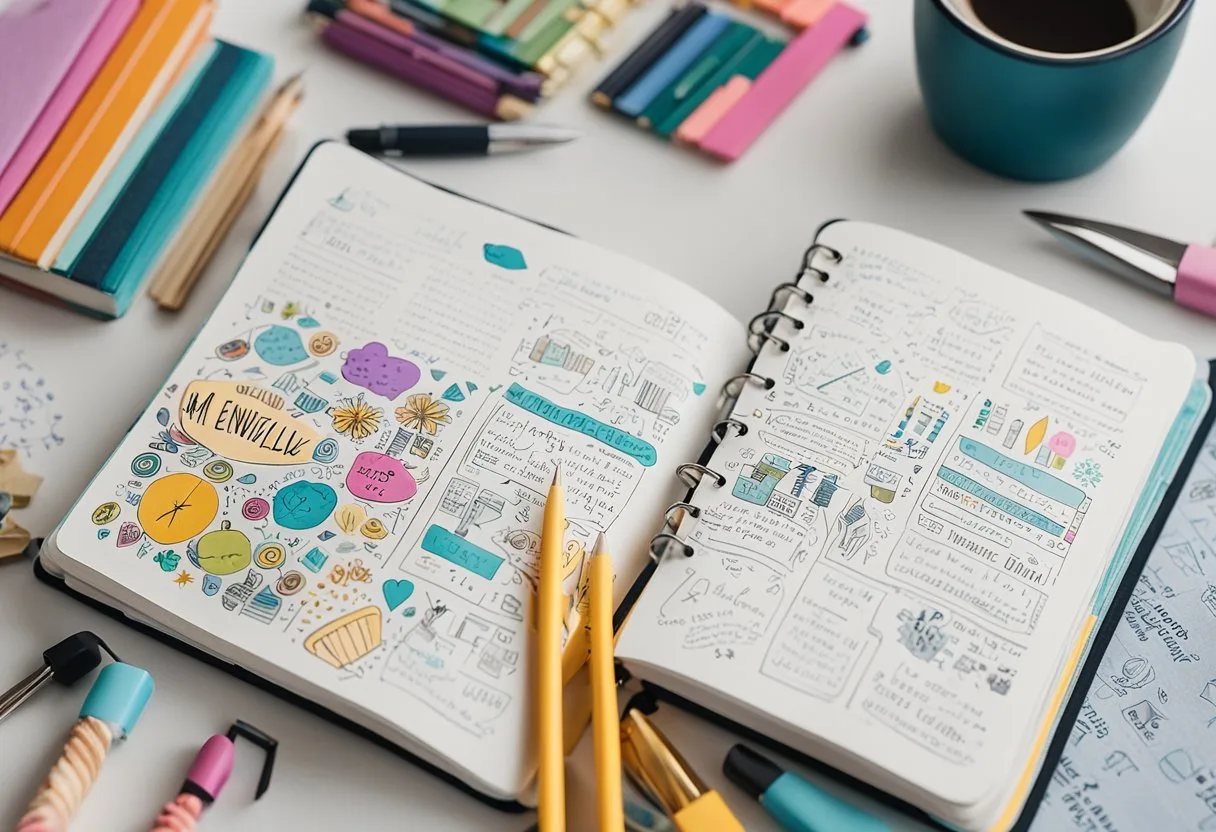Bullet journaling, also known as bujo, is a popular method of organizing and planning one’s life. It is a simple yet effective system that can help individuals track their daily tasks, set goals, and reflect on their progress. The system was created by Ryder Carroll, a digital product designer, as a way to help people declutter their minds and increase their productivity.
The bullet journal is essentially a blank notebook that can be customized to fit the user’s needs. It consists of four main components: an index, a future log, a monthly log, and a daily log. The index serves as a table of contents for the journal, while the future log is used to record events and tasks that will happen in the coming months. The monthly log is a place to record tasks and events for the current month, while the daily log is used to record tasks and events for each day.
Bullet journaling has become increasingly popular in recent years because of its flexibility and adaptability to different lifestyles. It can be used to track anything from daily habits to long-term goals, and it can be customized to fit the user’s unique needs and preferences. Whether one is looking to increase their productivity, reduce stress, or simply stay organized, the bullet journal is a powerful tool that can help them achieve their goals.
Getting Started with Your Bujo Journal
Bullet journaling is a popular method of keeping track of tasks, events, and notes in a customizable and creative way. If you’re new to bullet journaling, getting started can seem overwhelming. This section will guide you through the process of setting up your first bujo journal.
Choosing Your Bujo Tools
Before you get started with your bullet journal, you’ll need to choose the right tools. The most important tool is the notebook, which should have pages that are thick enough to prevent bleed-through. You can choose between lined, dotted, or blank pages depending on your preference.
Pens and markers are also essential tools for bullet journaling. Black pens are commonly used for writing, while colored pens and markers are used for adding color and decoration. Washi tape is another popular tool that can be used to add patterns and color to your bujo pages.
Understanding the Bujo Method
The bullet journal method was created by Ryder Carroll and is based on a simple system of bullet points. The method involves creating an index, a future log, a monthly log, and a daily log. The index is used to keep track of the pages in your bullet journal, while the future log is used to record events and tasks that are planned for the future. The monthly log is used to record events and tasks for the current month, while the daily log is used to record events and tasks for each day.
Setting Up Your First Pages
To set up your first pages, start by creating an index at the beginning of your notebook. This will help you keep track of the pages in your bullet journal. Next, create a future log where you can record events and tasks that are planned for the future.
Then, create a monthly log for the current month, where you can record events and tasks for each day. Finally, create a daily log for each day, where you can record events and tasks for that day.
Getting started with your bullet journal involves choosing the right tools, understanding the bullet journal method, and setting up your first pages. With a little bit of practice and creativity, you’ll be able to customize your bullet journal to fit your needs and preferences.
Structuring Your Bujo
When it comes to structuring your bullet journal, there are a few key elements to consider in order to make it both functional and personalized. Creating an index and key, designing monthly, weekly, and daily logs, and incorporating collections and trackers are all important aspects to consider.
Creating an Index and Key
One of the foundational pages in the bullet journal structure is the index page. Having a personal table of contents is essential in a bujo. This page should include a list of all the topics and pages in your journal, along with their corresponding page numbers. This will help you quickly find previously recorded topics, and make it easier to navigate your journal overall.
In addition to the index, you should also create a key page. This page will serve as a guide to the different symbols and notations you use in your bullet journal. For example, a dot might represent a task, a circle might represent an event, and a dash might represent a note. Creating a key will help you quickly identify and distinguish between different types of entries in your journal.
Designing Your Monthly, Weekly, and Daily Logs
The next step in structuring your bullet journal is designing your monthly, weekly, and daily logs. These logs will serve as the backbone of your journal, and will help you stay organized and on track.
- Your monthly log should include an overview of the month ahead, including important dates and events. This can be in the form of a calendar or a list, depending on your preference.
- Your weekly log should include a detailed breakdown of each week, with space for tasks, events, and notes. This can be in the form of a traditional weekly spread, or a more customized layout that works for you.
- Your daily log should include a detailed breakdown of each day, with space for tasks, events, and notes. This can be in the form of a traditional daily spread, or a more customized layout that works for you.
Incorporating Collections and Trackers
Finally, incorporating collections and trackers into your bullet journal can help you stay on top of your goals and projects. Collections are pages dedicated to a specific topic or theme, such as books to read, movies to watch, or travel plans. Trackers are pages dedicated to tracking specific habits or goals, such as exercise, water intake, or savings.
Structuring your bullet journal is all about finding a system that works for you. By incorporating these key elements, you can create a functional and personalized journal that helps you stay organized and productive.

Bujo for Personal Development
Bullet journaling is not just a tool for organizing your schedule and to-do lists, it can also be a powerful tool for personal development. By tracking your habits, setting goals, and reflecting on your mental health and well-being, you can use your bullet journal to make positive changes in your life.
Habit Tracking and Goal Setting
One of the most popular uses of a bullet journal is habit tracking. By creating a simple chart or table in your journal, you can track your progress on daily, weekly, or monthly habits. This can include anything from drinking more water to practicing meditation. By tracking your progress, you can identify patterns and make adjustments to improve your success.
In addition to habit tracking, a bullet journal is also a great tool for setting and tracking goals. By breaking down larger goals into smaller, achievable steps, you can make progress towards your goals every day. This can include anything from career goals to personal goals like learning a new skill or hobby.
Health and Fitness Logs
Another popular use for a bullet journal is tracking health and fitness. This can include tracking exercise, food intake, sleep, and even creating a meal plan. By tracking your progress, you can identify areas for improvement and make adjustments to reach your health and fitness goals.
Mental Health and Reflection
Finally, a bullet journal can also be a tool for mental health and reflection. By creating a gratitude log, you can focus on the positive aspects of your life and improve your overall well-being. By reflecting on your emotions and experiences, you can identify patterns and make positive changes in your life.
A bullet journal can be a powerful tool for personal development. By tracking your habits, setting goals, and reflecting on your mental health and well-being, you can make positive changes in your life and achieve your goals.
Creative Expression in Bujo
Bujo journaling is a creative outlet that allows individuals to express themselves in unique and personal ways. The beauty of bullet journaling is that it can be customized to fit anyone’s individual style and preferences. Here are some ways to add creative expression to your Bujo journal.
Doodling and Drawing
One of the most popular ways to add creative expression to your Bujo journal is through doodling and drawing. This can be done in a variety of ways, from simple sketches to more intricate drawings. Adding drawings to your Bujo journal can help to personalize it and make it feel more like your own.
Customizing with Stickers and Washi Tape
Another way to add creative expression to your Bujo journal is by customizing it with stickers and washi tape. These can be used to add color, texture, and personality to your journal. Stickers and washi tape come in a variety of styles and designs, making it easy to find ones that fit your personal style.
Themed Spreads and Collections
Themed spreads and collections are another great way to add creative expression to your Bujo journal. These can be based on anything from favorite movies and TV shows to personal interests and hobbies. Themed spreads and collections can be used to keep track of goals, tasks, and ideas related to the theme.
Creative expression is an essential part of Bujo journaling. Whether it’s through doodling and drawing, customizing with stickers and washi tape, or themed spreads and collections, there are many ways to add personal touches to your journal. Bujo journaling is all about making it your own and expressing yourself in a unique and creative way.
Bujo for Students and Professionals
Bullet journaling, or Bujo, is a flexible and customizable system that can be used by students and professionals alike. It is a great tool for organizing one’s academic and career plans, increasing productivity, managing time, and tracking progress on projects.
Academic and Career Planning
One of the most useful applications of Bujo is in academic and career planning. Students can use it to keep track of assignments, deadlines, and grades. They can also use it to plan out their course schedules, set academic goals, and track their progress towards those goals. Professionals can use it to keep track of their career goals, job applications, and networking opportunities.
Productivity and Time Management
Bujo can also be used as a productivity and time management tool. By breaking down tasks into smaller, more manageable steps, users can increase their productivity and reduce procrastination. They can also use it to prioritize tasks, set deadlines, and track their progress. Bujo can be used to schedule appointments, meetings, and other important events.
Project Tracking and Notes
Another useful application of Bujo is in project tracking and note-taking. Users can create spreads to track their progress on projects, including deadlines, milestones, and resources. They can also use it to take notes during meetings, brainstorming sessions, and other work-related activities. By keeping all of their notes and project information in one place, users can easily refer back to them as needed.
Bujo is a versatile tool that can be used by students and professionals to increase productivity, manage time, and track progress on projects. By customizing it to their specific needs and preferences, users can create a system that works best for them.
Frequently Asked Questions
What are the essential components of a bullet journal?
A bullet journal typically consists of an index, future log, monthly log, daily log, and collections. The index serves as a table of contents, while the future log allows you to plan ahead for the coming months. The monthly log is where you can track events, appointments, and tasks for the month, while the daily log is where you can plan and track your daily activities. Collections are pages dedicated to specific topics or projects.
How does bullet journaling improve productivity and organization?
Bullet journaling can help improve productivity and organization by allowing you to track your tasks and goals effectively. It also helps you prioritize tasks and identify areas where you can improve your time management skills. By having all your tasks and notes in one place, you can reduce the chances of forgetting important deadlines or appointments.
What are the best practices for setting up a bullet journal key?
The bullet journal key is a system of symbols used to represent different tasks and events. It is essential to set up a key that works for you and that you can easily remember. A common key includes symbols for tasks, events, notes, and priorities. It is also important to use colors and highlighters to help differentiate between different types of tasks and events.
Can bullet journaling be effective for managing ADHD, and if so, how?
Bullet journaling can be an effective tool for managing ADHD by providing structure and organization to daily activities. It can help individuals with ADHD prioritize tasks, manage their time, and reduce distractions. It is recommended to use a simple and straightforward layout, avoid clutter, and use color coding to help stay focused and organized.
What are some creative ways to personalize my bullet journal?
There are many ways to personalize your bullet journal, including adding stickers, washi tape, and drawings. You can also use different colors and fonts to make your journal unique. It is important to remember that the bullet journal is a tool for productivity and organization, so it is essential to strike a balance between creativity and functionality.
Where can I find templates and resources to start bullet journaling?
There are many resources available online to help you get started with bullet journaling. Websites like Pinterest and Instagram offer a wealth of inspiration and ideas for layouts and designs. You can also find printable templates and guides online to help you get started. It is recommended to start with a simple layout and gradually add more complexity as you become more comfortable with the system.



